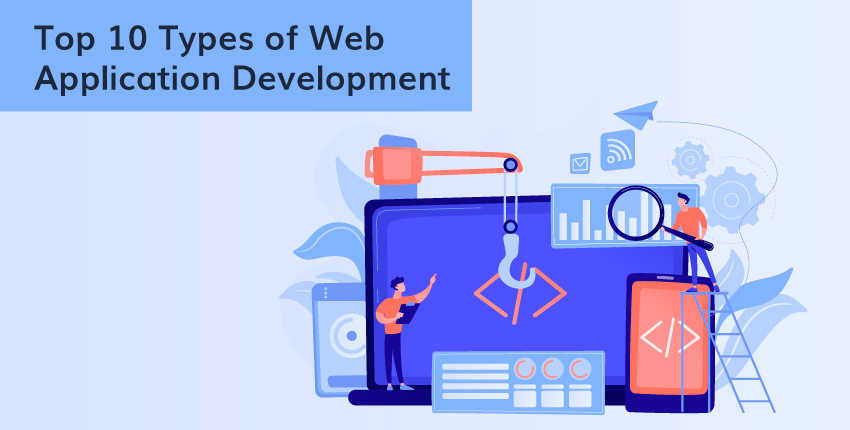- April 25, 2023
- Posted by: 10bits_mexican
- Category: Application Development

Web application development has been crossing all limits of innovation and evolution. It is indispensable for businesses and customers, leveraging the web’s multifold benefits. Due to the internet’s changes, web applications are wider than simple, static, or dynamic pages.
This blog post explores some more types of web development applications. Let’s get started.
-
Rich Internet Application
Rich internet applications (RIAs) are like traditional desktop apps, except the former has high interactivity and multimedia functionalities. They have an advanced tech stack, including Java, HTML5, and Adobe Flash. These applications are highly accessible because they can run across platforms that have web browsers.
Unlike other web applications, RIAs provide enhanced user experience and customer engagement. This is ideal for apps that require high interactivity from users. Examples include online games, financial dashboards, etc.
-
Static Web Application
Static web apps are built with HTML, CSS, and JavaScript. These are simple websites that don’t integrate with any database or have server-side processing. So unless you update it manually, these websites won’t change. That said, these applications are ideal for businesses that need apps to just display their “about” and contact information to their customers.
Though static web applications are easy to build and less time-consuming, their functionality is limited to basic features, so they are not scalable.
-
Multi-Page Application
Multi-page apps have multiple pages, each with a separate HTML file. So when the user lands on a particular page, the HTML file loads individually. These apps have links or a navigation menu that enables visitors to switch between the different pages of the web app. They are an integral part of simple and complex web apps.
Besides, multi-page apps are more SEO-friendly than other web apps because you can optimize each page for different keywords.
-
Dynamic Web Application
Dynamic web apps have dynamic content that changes with user interaction. They are built on server-side languages like Ruby, PHP, or Python. They are used for storing and retrieving information from different sources. These applications usually find a place in blogs, social media networks, etc.
Since dynamic web apps provide more customization and interaction options, they enhance user experience. Besides, they are scalable because of the ability to generate information based on input from the users.
-
Content Management System Web Application
A CMS (content management system) is a highly customizable, easy-to-use, and dynamic web app that allows non-technical marketing people and teams to create and manage digital content on their websites. With its user-friendly interface, you can add, update, or delete content from websites, blogs, and other pages without technical know-how.
CMS web apps are ideal for businesses that need frequent content updates or display a large amount of it on their websites. Some popular examples include Joomla, Drupal, WordPress, etc.
-
eCommerce Application
eCommerce applications are designed to carry out online transactions, including buying and selling goods, making payments, etc. These apps allow businesses to create product catalogs, carts, and payment systems that help customers select and purchase goods of their choice. They allow seamless management of products, orders, customers, and related functionalities.
eCommerce applications are generally built on WordPress, Shopify, Magento, etc. Besides, they need additional resources to build, maintain, and secure the application.
-
Progressive Web Application
Progressive web apps provide a mobile-like experience to web users. They eliminate the need to download or install a mobile app and render a similar experience on a web browser. These apps can work across platforms and on any device. Features like push notifications, offline caching, and home screen installation make these apps popular among the masses.
PWAs offer additional benefits like faster load times, offline working capabilities, and improved accessibility. Apart from this, they are easy and less expensive to build.
-
Portal Web Application
A portal web app is a centralized platform to collect resources and services used by organizations and businesses. It allows them to access information from their employees, customers, or visitors. These apps have features like a search function, integration with different systems, user authentication, and content management.
Portal web apps are also built on server-side programming languages like .NET or Java. Some popular examples include Liferay and Microsoft SharePoint.
-
Single Page Application
Single-page apps load a single page based on HTML and load content dynamically when fed with user interaction. They don’t need a full-page reload to respond to user actions because they use AJAX and web sockets. This leads to faster load times and a smooth transition between different pages.
SPAs are common among social networking sites and productivity tools that need a high level of interactivity with customers.
-
Animated Web Application
Animated web apps use visual effects and animations to improve user experience and engagement on websites. They are built on HTML, CSS, JavaScript, and other animation frameworks and libraries. These apps also help businesses improve their customer retention rates.
Animated web apps find their application in gaming, marketing, and educational apps where users require high interactivity and engagement levels to stay tuned to the apps.
Choose Your Web Application Wisely!
If you are willing to invest in a web application, consider the options listed above and make an informed decision. But if you have more specific ideas and need consultation for web application development in the USA, connect with 10Bits to find the best service providers in the USA.
